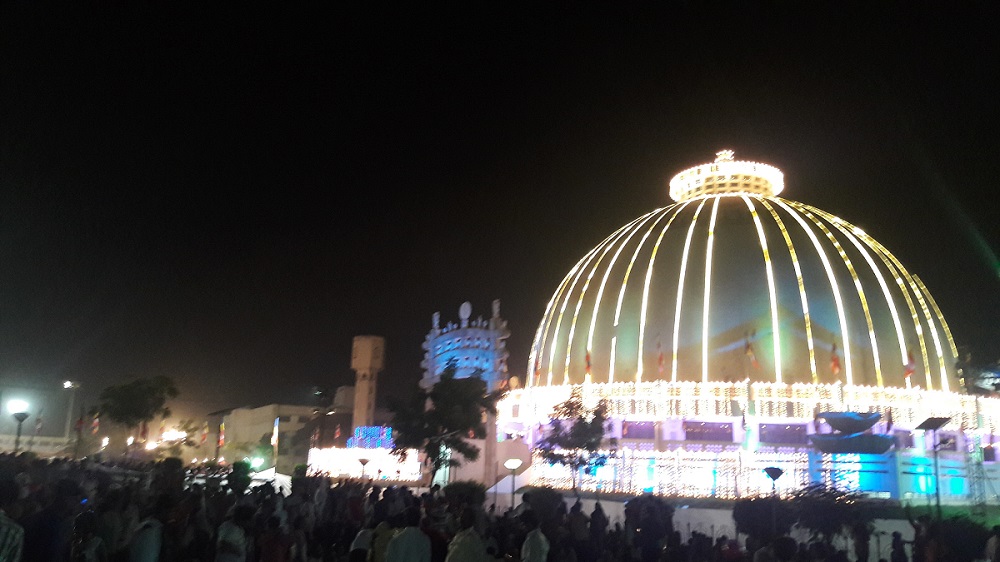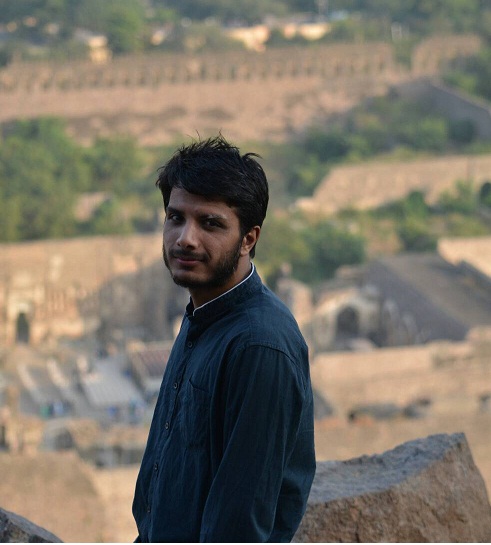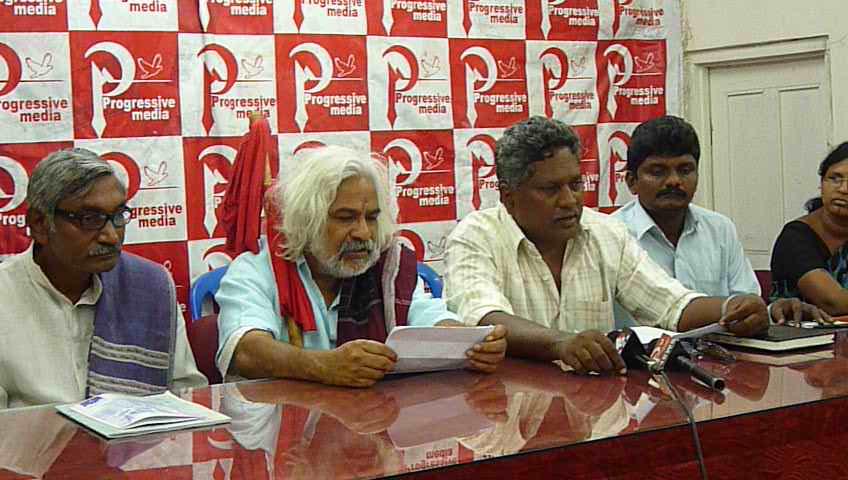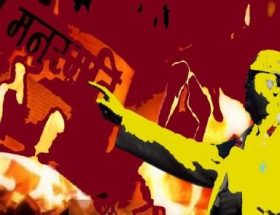Mahipal Mahamatta and Adhvaidha K
“Though, I was born a Hindu, I solemnly assure you that I will not die as a Hindu”, Babasaheb proclaimed in the speech delivered at Yeola in 1936. His decision was the culmination of inequality, inferiority and inhuman treatment given by Hindu religion to fellow human beings. In the modern cultural history, nothing could be a more revolutionary decision than this.
Babasaheb made us realize that Hindu religion is the perpetrator of caste and to break the shackles of caste is to liberate oneself from that religion. It is the religion of superstition that leaves no space for one to question its fundamental structure. It legitimizes and guards its self-proclaimed rules. It does not encourage change. It is not more than a religion of inequality. It leads to human degradation. Hinduism thrived for ages on the ‘base of social hierarchy’ that it created. It cannot sustain itself on rationality or growth or equality.

In his book Revolution and Counter-Revolution in Ancient India, Babasaheb identifies that ‘The history of India is nothing but a mortal conflict between Buddhism and Brahmanism’. Buddhism with its core principles of liberty, equality and fraternity always stood against inhuman values, graded inequalities which were the core of Brahmanism. Ambedkar was well aware of the potential of Buddhism to build an egalitarian order in society as that is also the crucial way towards the annihilation of caste.
The conversion to Buddhism that Babasaheb undertook along with lakhs of people, on October 14th, 1956 was an act that chose liberation over salvation in heaven. By conversion, people did not just assert their liberation from the unjust Hindu order but they chose the path of creating a whole new society on the basis of Wisdom, Character, and Compassion. The conversion was not just a one-point program against Hindu religion, rather it was for establishing a new order based on universal morality embedded in Buddhism. It has been more than 60 years since Ambedkar converted to Buddhism in Nagpur. This city is also known as ‘Deekshabhumi’ (Land of Initiation to Buddhism) as Ambedkar had given vows to millions of his followers who initiated themselves into Buddhism. To remember this revolutionary act and to pay tribute to Ambedkar, millions of people come to Deekshabhumi every year from different villages, towns, and even across the country and some parts of the world, since 1956.
October 14th, due to its historical importance, is celebrated worldwide, and has also become a cultural festival for Buddhist people. This fest is known as ‘Dhamma Chakra Pravartan Din’. In 2016, as student researchers, we had been to Deekshabhumi as a part of our curricular work. This did not reduce our love for Deekshabhumi or us to ‘outsiders’ since being Ambedkarites we are intrinsically connected to the place and have been there many times in the past. But as researchers this was the first time we had been at Deekshabhumi. This article is a sincere attempt to put forth Deekshabhumi as a site of knowledge production, as a school of common people based on our observation, interviews and interactions at the place.
Once you enter Deekshabhumi, you forget your ‘self’ or individuality or it gets dissolved and become a part of larger society, created by the crowd present there which is organic in itself. Many people come in groups from their native places. We could see people from different states like Karnataka, Andhra Pradesh, Tamil Nadu, Kerala, Uttar Pradesh, Gujarat, Arunachal Pradesh, Odisha, Bihar, and Chhatitsgarh marching on the street towards Deekshabhumi with their organization’s flags, banners and slogans of ‘Jai Bhim’. We encountered Japanese, Taiwanese, and Malaysian people in a group showcasing their work in the field of Buddhist teaching and distributing contact cards of their organizations. Many women from villages come wearing white saris in rural style carrying bags on their heads. Most of these women come independently. When asked, where is your husband? They would answer instantly, that we came as women, and he must be with other men. We spoke to a woman from a small village whose husband could not come, as he had to water the land of the landowner. But that lady came despite her husband’s absence. She said, ‘Ambedkar had given me self-respect, shouldn’t I pay him my tribute? If he is watering the land then who has stopped me from coming here to follow my duty?’ One could see all demographic classifications, that is, with respect to the age group, except for the newly born and dead. Cultural groups from Maharashtra as well as from other states perform singing, drumming in a place, which is automatically circled by people to motivate the artist as well as to motivate themselves. Many ballad singers sing Ambedkarite songs sitting on the footpath, the powerful content of the songs and the rhythm of the tabla gets the attention of the people.
Samata Sainik Dal (SSD) administers and regulates the crowd efficiently so that people do not face any difficulty and should not feel insecure. Local Ambedkarite organizations in Nagpur arrange food, water, and health facilities to the people day and night. Police administration cooperates with the people in terms of safety and security but that does not imply all is well. A man wearing a white shirt and pants in his 50s started fighting with the police to use proper words and eventually police had to accept it. The police were giving instructions in general on mikes saying, “All devotees, please pay attention here” while the man got angry at the police and said, “This is not a temple where a deity is residing and we are not devotees who have come here for any pilgrimage. We are not Hindus. Don’t use the word ‘devotee’ for us, use ‘Ambedkarites’ or ‘Ambedkar’s followers’. For generations, we fought to distance ourselves from God and in one go you are nullifying it”. People there supported him and the police instructor apologized and changed the word.
This is only one little scene that we could catch roughly within our limited capacity. Generally, researchers and academicians and ‘outsiders’ get puzzled, shocked or deeply surprised on seeing so many people gathered at one place.
We ourselves, being the subjects at Deekshabhumi, know very well why people come or why we come here. Some come to Deekshabhumi for quenching our spiritual thirst, some consider their visit as social responsibility, some feel that this place is the best place in the world to cultivate the mind, some see Deekshabhumi as source and symbol of knowledge, some imagine it as a centre of movement and mass awareness; some arrive to socialize themselves and their family with Ambedkarite lifestyle. The answers differ from individual to individual but there is a point where all answer meet. That point is obviously Deekshabhumi, which enjoys tremendous respect and faith in the hearts of the people. However, this epistemological question ‘Why’ needs to be addressed properly. Hence, to check our understanding whether it is correct or not, we started our inquiry by interacting with some of the people and got to know – Why do they visit Deekshabhumi? Why do they take the pain of traveling by standing in the train all the way, where there is no space to stand even for an ant? Is it just to pay tribute to Ambedkar or something else lies there?
Mr. Manilal who is currently in his sixties is regularly visiting Deekshabhumi and Chaityabhumi since 25 years. He is here because he strongly feels that celebration of Dhamma Chakra Pravarthan Din is based on equality. He said he belongs to the Mali caste, which comes under the OBC category. When we ask, how he was introduced to Buddhism? He said that his father and grandfather were under the influence of Jotiba Phule’s thought. He said, “Phule always emphasized on equality but our community forgot Jotiba Phule’s teaching eventually. We just keep his frame in our home but actual knowledge of Phule and his ideas are with the Buddhist people. They respect Phule so much more than his own community. Buddhist people have strong unity. They have discipline and I could feel fraternity with them. They do not discriminate between the people unlike Patils in the village. I have observed that if you go to the temple, you have to pay money but such a thing is not here at Deekshabhumi. I had worked for 20 years in Sharad Joshi’s party on the issue of farmers. He got the name but distress of farmers is intact. I left the party, hoping better from these people. Based on what I observe at Deekshabhumi and Chaityabhumi, I strongly feel that these people can come to power in Maharashtra if their leaders are united. This hope keeps me marching towards the places. In my village, I have faith on this people more than my brother, as they are very liberal in thoughts, treat everybody equally and live their lives with self-respect.”
Mr. Manilal is a farmer from Shegaon in Buldhana District. Every year he buys a bus pass and travels by state bus to Deekshabhumi and Chaityabhumi on 14th October and 6th December respectively. After listening to him, we could not frame another question. We saw his deeply compassionate eyes and could see our thoughts resonating with his thoughts. We also strongly wish or hope for what he hopes.
 Mr. Manilal
Mr. Manilal
Another man in his 50s, whose father converted in 1956, was talking about Ambedkar and Buddhism. He said, “after studying all the religions for 21 years Babasaheb came to the conclusion that Buddhism is the only one where the welfare of humanity can be achieved. In those days, people used to gather in huge numbers at a call given by Ambedkar. When he gave a call for conversion, people without footwear, hungry stomachs flowed from villages to Nagpur. Hunger of stomach is different from hunger of mind. As we feed our stomach, we need to feed our mind too. Only then, human beings become healthy living beings. Food for the mind are ideas and thought. People coming here do not pray and ask for wealth and happiness like in the temples. They come here to grasp ideas and thought. They keep themselves alive throughout the year through the energy they source from those thoughts. This is the reason why I come here.”
Mr. Pradnyanand Bhagat is a ballad singer. We didn’t know that initially. Later on, when we asked him to sing a song, Pradnyanand started singing with great zeal and people slowly gathered around us. As we heard him singing we could see the way in which his thoughts were getting disseminated into every other mind present there through his songs.
After finishing the song, we offered thanks to the singer and wished him a happy life with Jai Bhim.

Mr. Pradnyanad Bhagat
While we say that Dhamma Chakra Pravartan Din and the rest of the Ambedkarite movement stands firmly through the assertion of the people from different social sections we also need to realize that these movements cut across various regions in the country and invites people to join the celebration. We were quite surprised to see the ‘Parai’ (drum) artists of Nila Dhamma Trust from Chennai, Tamil Nadu, who had come all the way to perform. The team with majority women artists caught the attention of the people through their powerful Parai beats. Professionally most of them were not Parai artists. Though they were all well settled as research scholars, professors, technicians in the airport, students and school children, they feel the need to hold the Parai to stand against fanaticism in society.
Ms.Gokilavani, one of the Parai artists and also a Ph.D. scholar, rightly said that the main objective of the Hindutva fanatics is to spread hatred among the people, particularly about the untouchables. The cowhide (the material that is generally used to make the parai) is not inherently polluted, they propagated that it is impure because the untouchables beat the Parai. In this way, they politicize the issue by constructing a myth that a cow is sacred and spread hatred towards the Dalits. She feels that the current political situation where human life has been reduced to worse than the life of an animal like the cow, make them hold the parai and demonstrate against the present political regime. She also said that “When a woman beats the parai, it becomes more powerful, meaningful and sharpens the parai as a symbol of emancipation. Hence beating the parai at Deekshabhoomi, on the day of Dhamma Chakra Pravartan Din becomes a political act which tears apart the sacredness of the cow”.

Ms.Gokilavani
Akash and Narshina Bouddh, 20-year-old students from Chhattisgarh, made a great impression on us by giving a historical reason for why they were standing at that place. Both of them were students of B.Sc Natural Science. However, their understanding of history was outstanding. They have been coming to Deekshabhumi for the past five years. They feel the connection to the history of Buddhism when they come here. For them, it is important to get the sense of their own history and culture. Meeting stalwarts and new people every year, knowing new things from them and broadening the connection with people so that the movement could be strongly consolidated. These are the benefits they find here. When we further question them about “What does historical sense mean?”, both of them answered that “Once prosperous Buddhism declined when the grandson of Emperor Ashoka was murdered by a Brahmin named Pushyamitra Shunga. Then he initiated the lynching of Buddhist people by offering gifts to the perpetrators. In this way, Buddhism saw its downfall since then. Ambedkar in 1956 revived Buddhism by doing a mass conversion, giving people 22 vows. Since then, Buddhism is spreading day by day in our country. Now it is our responsibility also to contribute to the further enhancement of Buddhism. This is the historical sense we are talking about”. We admire them for the way they were socializing themselves and people like us.

Narshina Boudh (in right) and Akash (in left)
We met these people at Deekshabhumi. However, while returning to Mumbai; many people were with us on the train. When the train halted at Manmad Railway station for 15 minutes, we came out of the train to relax. We were traveling with our good friend Pavan. A woman seated alone was looking at us with fondness. When we started talking to her, she felt happy and she said that ‘I saw you people at Deekshabhumi clicking photos and taking video of the people’. Suddenly she started crying and said, “You (Mahipal) look like my son!” Her son was in the military service at ‘Sagar’ post. He had died in an accident recently. She and her family were in deep trauma since then. Her elder son and other family members were not allowing her to visit Deekshabhumi in this situation of sorrow. “But I did not accept that”, She said. She added, “I am the mother, so only I can understand my sorrow but one day I have to come out of it. Today my existence is based on what Ambedkar has done for me. How shall I pay back what he has done for society and me? Because of him, another son is also in the military, and daughter is studying. Earlier, upper caste people in the village used to keep a distance from us, now they are coming to us asking for help. Ambedkar has given to all of us such a respectful life. I will come to Deekshabhumi, however big the obstacle is”. While listening to her, we could not stop ourselves from feeling emotional. When the train blew the horn, she asked our contact number so that she could contact us in Mumbai, when she visits Chaityabhumi on December 6th, Mahaparinirvana Din. She noted down our contact number on the inner cover page of one of the books she carried home from the bookstalls. We offered her Jai Bhim, took her blessings, and ran to catch the train. Pavan was still crying and mumbling, saying, “Valorous woman”.

‘The valorous woman’
Coming to the next question, do people come just to offer tribute to Ambedkar or something else is there with a deeper connotation? By reading the above narrations, one could feel that there is something, which is deeper than tribute. What is it? The answer lies in the various stalls present at Deekshabhumi. There were more than 300 stalls, used for various purposes at Deekshabhumi. Eminent Ambedkarite activists, writers, academicians, present in the stalls share their ideas, thoughts, and books. Many leading publishers affiliated with liberal ideology sell their books which in turn plays the role of a catalyst in understanding the issues in front of the movement. Many organizations affiliated to Ambedkarism, working in different areas of interest, give information about the aims and objectives of their organization. This creates ideological stimulation for many people present there. Revolutionary songs, get disseminated through cassettes. Students studying in higher education institutes give guidance and make the youth aware of higher education and various opportunities related to it. These stalls are the place where the beducated, prosperous Dalit interacts with the less educated less prosperous Dalit. One could identify this by looking at differences in the dress code or lifestyle markers. These stalls create a churning and synergy between them and differences in lifestyles do not become hurdles in knowledge dissemination.
Students present in the stalls give career guidance to the youth coming from rural areas. Some stalwarts in the different fields interact with the common masses with an open heart. Ambedkar in his famous speech ‘What path to Salvation?’ said that he won’t accept a religion in which only a small section of a class in the society has a right to gain knowledge. The religion that keeps the majority of the people in darkness with a view to educate a few people, is not a religion but a strategy to keep the people in mental slavery. Since ages, in terms of Jotiba Phule, “Women, untouchables, Shudra, Adivasis and fishermen were alienated from knowledge by incivility of Hindu religion.” Now the same people who were victims of incivility, turn to Deekshabhumi to shed their mental slavery, by grabbing knowledge, character, compassion (Pradya, Sheel, Karuna) which are core values of Navayana Buddhism. As Babasaheb said in ‘Buddha and his Dhamma’, that people have chosen liberation through knowledge over salvation in heaven. Deekshabhumi plays a pivotal role in producing and disseminating knowledge to the common masses by which they can seek their liberation. Now we could see the answer to the ‘epistemological why’, why do people come here? It is a school for commoners. And they love schooling.
~
References
Dr.B.R.Ambedkar, 1936. Annihilation of Caste.
Dr.B.R.Ambedkar, 1936. What path to salvation?
DR.B.R.Ambedkar, Revolution and Counter-Revolution in Ancient India.
Dr.B.R.Amebdkar, 1957. Buddha and His Dhamma.
~~~
Mahipal Mahamatta and Adhvaidha K, believe that practice and theory should go hand in hand. Being Ambedkarites, they are interested in reading and knowing about the past and present societies, around the world, that strive in various ways to attain equality. They feel more responsible and get joy when they articulate all the knowledge that they got and reflect them back in the form of art.










